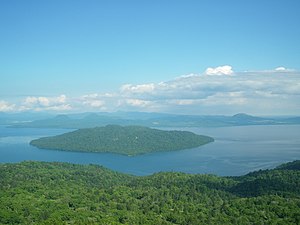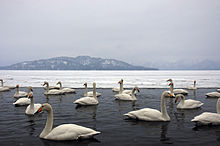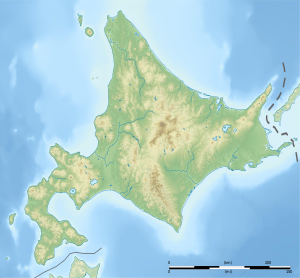Kussharo Lake
| Kussharo Lake | ||
|---|---|---|

|
||
| Lake Kussharoko in June 2008 | ||
| Geographical location |
|
|
| Tributaries | Atosa, Amemasu, Onnenai, Shikerepenbetsu, Onneshireto, Toikoi, Meshikimemu, Enetokomappu, Ossappe | |
| Drain | Kushiro | |
| Islands | Nakajima | |
| Location close to the shore | Teshikaga | |
| Data | ||
| Coordinates | 43 ° 38 ′ N , 144 ° 20 ′ E | |
|
|
||
| Altitude above sea level | 121 m TP | |
| surface | 79.54 km² | |
| volume | 2,250,000 m³ | |
| scope | 57 km | |
| Maximum depth | 117.5 m | |
| Middle deep | 28.4 m | |
|
particularities |
Crater lake , completely frozen over in winter |
|
The Kussharo Lake ( Japanese 屈 斜路 湖 , Kussharo-ko ) is a crater lake in Akan National Park in the east of Hokkaidō , the second largest island in Japan . In terms of area, it is the sixth largest lake or the largest crater lake, and in winter the only completely frozen lake in the country. The name Kussharo comes from the Ainu . There is a myth about the sea monster Kusshie ( suitcase word from Kussharo and Nessie ) that is said to live in Lake Kussharo.
location
Lake Kussharo is located in the Kushiro sub-prefecture on Hokkaidō and can be reached by National Road 243. This extends over the entire southwestern part of the lake and continues from there over the Bihoro Pass to Bihoro or, if coming from the west, to Teshikaga . To the west of the lake is the prefecture road 52, which connects the national road 243 to Kawayuonsen, where there is a connection to the national road 391, as well as a connection to the Kawayuonsen train station . From there, the road continues west to Lake Mashu , runs along its coast and ends again on National Road 243, but further southeast than the beginning.
Geography and chemistry

The center of the Kussharo Lake is the stratovolcano Nakajima, from which volcanic gas escapes and makes the lake acidic . As a result, with the exception of areas heavily polluted by currents, certain fish can live in Lake Kussharo. Rainbow trout were artificially released in Lake Kussharo and are resistant to the slightly acidic lake. Singing cicadas were discovered in 1951 and are now protected by the government. The whooper swan also migrated to Lake Kussharo.
There are numerous naturally heated springs and sandy beaches on the shore. Sulphurous winds are common from the Wakoto Peninsula to the lake.
Lake Kussharo has an area of 79.5 square kilometers and a volume of 2.25 cubic kilometers. The circumference is 57 kilometers and the lake has a water depth between 28.4 and 118 meters.
Inflows and outflows
Lake Kussharo has tributaries from the Atosa, Amemasu, Onnenai, Shikerepenbetsu, Onneshireto, Toikoi, Meshikimemu, Enetokomappu, and Ossappu, which are numerous small rivers. The Kussharo Lake has the Kushiro as its drain , from which the water finally flows into the Pacific .
The sea monster Kusshie

Similar to Loch Ness , the myth lives that a sea monster , which has been named Kusshie ( ク ッ シ ー , Kushī ) in the press since 1973 , is supposed to be up to mischief in Lake Kussharo.
Web links
- Basic information (PDF; 4.9 MB) about Lake Kussharo
Individual evidence
- ↑ 湖沼 面積 . (PDF; 114 kB) Kokudo Chiriin , October 1, 2015, archived from the original on August 5, 2016 ; Retrieved August 5, 2016 (Japanese).
- ↑ a b c d e GSI folder 25000: 1 屈 斜路 湖
- ↑ a b 日本 の 主 な 湖沼 . MLIT , 2002, archived from the original on September 12, 2013 ; Retrieved September 15, 2013 (Japanese).
- ↑ cf. Google Maps
- ↑ 釧 路 川 . In: 日本 河川 図 Rivers in Japan. Retrieved July 2, 2013 (Japanese / English).
